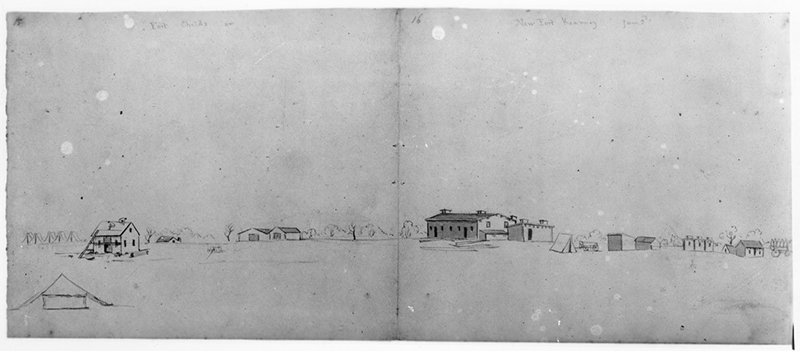Fort Kearny was an important stop along the Platte River Road, the route shared by the Oregon, California, and Mormon trails. Some did not think it looked like a fort at all.

By David L. Bristow, Editor
Fort Kearny was an important stop along the Platte River Road, the route shared by the Oregon, California, and Mormon trails. The army established the post in 1848 south of present-day Kearney. Originally known as Fort Childs, it was soon renamed in honor of Stephen Watts Kearny, a US general in the Mexican-American War.
During the 1849 gold rush the fort was still an unfinished collection of sod buildings. This sketch is among the earliest images.
Travelers differed in their opinions of the place. Some did not think it looked like a fort at all. “It is on low land some half mile from the river,” wrote John Edwin Banks in 1849. “It consists of about twenty houses made of sod, some roofed with the same material, walls two feet thick. They must be very warm. There is neither blockhouse or palisade. A few soldiers and two or three cannon are all the evidence one has that it is not some outlandish village.”
Writing in 1852, a traveler identified only as S.M.B. told the Missouri Republican that “Fort Kearny is a sort of one-horse affair, stuck down in the mud on the wrong side of the river, and a long distance from wood and every other comfort, the site of which must have been selected by some person who did not know what he was doing.”
The army added new buildings over the years. In 1859, gold miner John T. Gibson described the fort as “quite a respectable little place. Got dinner at 75 cents a head, and enjoyed the good things of mine host amasingly [sic], but felt it somewhat odd sitting at a table, instead of squatting on the ground, as we have been so long accustomed to do.”
Fort Kearny also served as a station for freight wagons and stagecoaches, and as a post office and Pony Express station. Never under attack, it served as an outfitting depot for several military campaigns against Native tribes.
The fort closed in 1871; it has been a state historical park since 1959.

Detail of sketch. History Nebraska RG2102-1-8
This article first appeared in the April 2021 issue of NEBRASKAland Magazine.
References
John T. Gibson, May 26, 1859 (History Nebraska, RG1024.AM), Typescript of a diary April 18-September 11, 1859. From Marengo, Iowa, to California.
Letter from traveler identified only as S.M.B., Missouri Republican, July 1, 1852. Nebraska State Historical Society Publications XX, 239.
John Edwin Banks, 1849. From Banks, John Edwin and Howard Scamehorn, ed., The Buckeye Rovers in the Gold Rush, 1965, 19.



